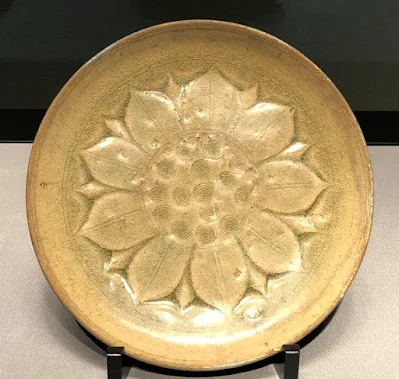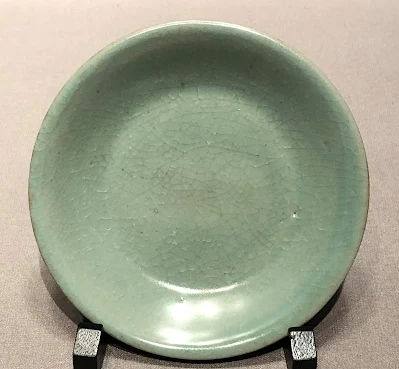These dishes are similar in the size, shape and origin, but their colors are different because of different glazes and firing processes as follows:
White (Picture 1) = White glaze + reduction firing*
Brown (Picture 2) = Celadon glaze + oxidation firing*
Blue (Picture 3) = Celadon glaze + reduction firing*
* See below for details.
 |
| 1. White dish with lotus flowers, Northern Song dynasty, 11th-12th century, China 白磁刻花蓮花文皿 |
 |
| 2. Celadon dish with lotus flowers, Southern dynasties, 5th-6th century, China 青磁蓮弁文盤 |
 |
| 3. Celadon dish, Northern Song dynasty, 11th-12th century, China 青磁盤 |
Sufficient oxygen in the kiln, which allows "oxidation firing," produces brownish celadon like the second picture, while insufficient oxygen, leading to "reduction firing," produces white and celadon blue/green colors.
Although humans can decide which glaze to use, they cannot control the color of porcelain after all.
Although humans can decide which glaze to use, they cannot control the color of porcelain after all.
(If you wish to post your comment but don't have a Google account, select "anonymous" from the drop down menu titled "comment as"!)
最近よく東京国立博物館に行きます。で気づきました。同じような丸いお皿(中には模様もほぼ同じものもある)がたくさんあるけど色が違うのはどうして?調べてみました。
写真1 白磁 = 透明な釉薬 + 還元焼成
「還元焼成」とは窯の中の酸素が少な目なので青色や白色、
写真2 米色青磁 = 青緑釉 + 酸化焼成
写真2 青磁 = 青緑釉 + 還元焼成
「還元焼成」とは窯の中の酸素が少な目なので青色や白色、
「酸化焼成」は酸素たっぷりなので黄褐色になるとのこと。
使う釉薬を決めるのは人間だけど、色を決めるのは結局、神様なんですね(笑)。
(Google アカウントを持ってない方がコメントする場合は、「Google アカウント」をクリックし、「匿名」か「名前/URL」を選択してからご記入ください!)
0 件のコメント:
コメントを投稿